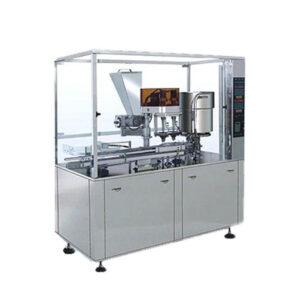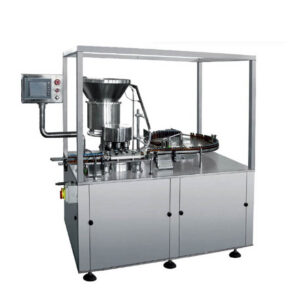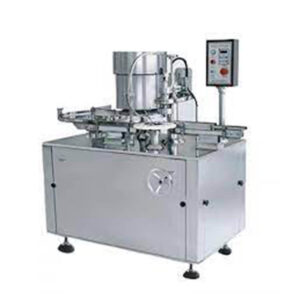Description
| Feature | Specification |
|---|---|
| Machine Type | Aseptic Blow-Fill-Seal System |
| Container Type | Plastic Containers for Large Volume Parenterals (LVP) |
| Sterilization Method | Aseptic Processing |
| Container Size Range | [Specify range in ml or liters] |
| Filling Volume Range | [Specify range in ml or liters] |
| Blow Molding Material | [Specify material e.g., Polyethylene (PE)] |
| Filling Accuracy | [Specify accuracy e.g., ±0.5%] |
| Sealing Method | Heat Sealing |
| Aseptic Environment Class | [Specify class e.g., ISO 5] |
| Production Capacity | [Specify in units per hour or minute] |
| Control System | [Specify e.g., PLC (Programmable Logic Controller)] |
| Power Supply | [Specify voltage and frequency] |
| Operator Interface | [Specify e.g., Touchscreen HMI] |
| Material Compatibility | [Specify compatibility with parenteral solutions] |
| Compliance | [Specify relevant standards e.g., cGMP, FDA] |
| Optional Features | [List optional features if applicable] |
Pharmaceutical manufacturing, parenteral products especially Large Volume Parenterals (LVP), requires safety and sterility. Several advanced techniques have been created to enable the industry to meet the tough demands including the AFP Aseptic Blow-Fill-Seal (BFS) system. Developed by Automated Flexible Packaging (AFP), this system epitomizes innovation in aseptic packaging customized to plastic container parenterals. In this article, we will discuss the AFP Aseptic BFS system’s working processes; applications, functions and benefits as well as their significance in modern pharmaceutical manufacturing.
Working Processes of AFP Aseptic Blow-fill-seal System
The production of sterile and high-quality plastic container parenteral preparations is accomplished by several sophisticated processes that are seamlessly integrated into the structure of the AFP Aseptic BFS system:
Blow Molding: This process commences with the extrusion of a hollow parison or preform known as plastic resin such as polyethene (PE) or polypropylene (PP). This parison goes into a mould cavity where it is inflated using compressed air to reach the required shape of the container. Using blow moulding ensures control over container dimensions and characteristics.
Aseptic Filling: After being formed, the containers are moved to a filling station while ensuring asepsis. These fillings are done through volumetric or gravimetric filling methods accurately designed for injection solutions. The filling process is carried out under controlled conditions so as not to contaminate with microorganisms.
Sealing: Following filling, glass ampoules are sealed hermetically together resulting in their maintenance of sterility and integrity too. Normally, the necks, as well as lids regions on these containers, get heated before pressure/vacuum sealing them tightly. Henceforth, it becomes possible to minimize ingressions thereby avoiding contamination effects from entering these packages.
Sterilization: Before being filled with fluids during production, all parts that make the BFS system, including moulds, filling needles and sealing equipment are subjected to sterilization such as steam sterilization or gamma radiation. Due to this, the surface contacts remain free of microbial contamination throughout production.
Applications of AFP Aseptic Blow-fill-seal System
Across the different areas of the pharmaceutical industry, particularly in large-volume parenteral (LVP) plastic containers, the AFP Aseptic BFS system is widely used. The major applications include;
Intravenous Fluids: This technique is used to manufacture common intravenous fluids such as saline solutions, dextrose solutions and Ringer’s lactate solution. These fluids are administered in a clinical setting for fluid replacement, electrolyte balance and drug administration.
Sterile Irrigation Solutions: Sterile irrigation solutions commonly used for wound cleansing, body cavity irrigation and surgical purposes can be made through the AFP Aseptic BFS system. Hence their manufacturing requires strict aseptic processing to prevent post-operative infections.
Parenteral Nutrition: The technology of BFS has been employed in producing nutrient solutions such as amino acids essential carbohydrates lipids for parenteral nutrition. Such formulations are important in cases where patients can’t get enough nutrition through oral routes.
Dialysis Solutions: Hemodialysis and peritoneal dialysis solutions produced using the AFP Aseptic BFS system are critical for renal replacement therapy in kidney failure patients. For patient safety, these must meet stringent quality standards.
Functions of AFP Aseptic Blow-fill-seal System
This pharmaceutical process incorporates several vital functions by which it performs as part of its purpose which include;
Aseptic Processing: It enables sterile production of drugs minimizing the possibility of microorganisms contaminating during manufacturing by using sterile processing zones joined with high-efficiency particulate air (HEPA) filtration together with tough sanitization procedures.
Container Manufacturing: It is a technology that uses blow moulding to make plastic containers of specific characteristics and sizes. Through this, there can be optimization of container design to match specific product needs and packaging preferences.
Rapid Production: The AFP Aseptic BFS system has a capacity for high-speed production that is beyond traditional filling methods. For this reason, pharmaceutical manufacturers can meet the increasing demand while keeping productivity and efficiency intact.
Product Integrity: By controlling filling, sealing and sterilization processes with precision, the system guarantees integrity as well as stability of the final product. This is crucial in safeguarding the therapeutic effectiveness and safety of parenteral formulations over their shelf life.
Benefits of AFP Aseptic Blow-Fill-Seal System
The AFP Aseptic BFS system is known for its numerous benefits to pharmaceutical manufacturers, and healthcare providers among others:
Assured Enhanced Sterility: In comparison with traditional filling methods, the closed automated nature of the BFS process minimizes human intervention and lowers the risk for microbial contamination, thereby offering better sterility assurance.
Reduced Cross-Contamination Risk: The BFS system relieves the risks associated with manual handling of containers during intermediate storage thereby reducing cross-contamination between different product batches thus improving quality and safety.
Increased Operating Efficiency: Pharmaceutical firms can improve operational efficiency by optimizing production throughputs using low cycle times offered by the high-speed production capability of the BFS system which leads to enhanced cost-effectiveness
Extended Product Shelf Life: Preservation against environmental contaminants and maintenance of product stability over time through aseptic packaging as well as sealing using the BFS system on parenteral products ensures longer shelf life.
Customizable Container Designs: Blow moulding technology brings flexibility in terms of shapes sizes or configurations that can be used when producing different kinds of containers thus helping pharmaceutical firms differentiate their products depending on market demands.
Roles played by AFP Aseptic Blow-Fill-Seal System
This includes:
Primary Packaging Solution: Among other sterile pharmaceutical products, the BFS system is a primary packaging solution for LVPs, ophthalmic solutions, and respiratory therapies.
Quality Assurance Tool: The incorporation of advanced monitoring and control systems into the BFS system ensures that regulatory requirements and industry standards concerning aseptic processing and product quality are met.
Technology Enabler: The adoption of BFS technology enables pharmaceutical companies to leverage automation, robotics, and advanced materials to enhance manufacturing efficiency, product quality, and innovation.
Market Differentiator: By providing superior-quality, aseptically-packaged products that satisfy the emerging needs of healthcare providers and patients; firms investing in AFP Aseptic BFS technology have an edge over their competitors.
Advantages of AFP Aseptic Blow-Fill-Seal System
Compared to traditional packaging as well as filling methods there are several benefits of using the AFP Aseptic Blow-Fill-Seal system such as:
Single-Step Production: Instead of multi-step filling processes used in traditional ways of doing things, the BFS technique combines container formation with filling and sealing into just one continuous process eliminating many handling steps or processing stages featuring other non-uniform production methods.
Reduced Environmental Footprint: The use of pre-formed containers can be avoided by employing this method thereby minimizing secondary packing substances besides lowering power consumption thus enhancing sustainability with reduced environmental impact.
Improved Product Safety: By maintaining sterility and integrity during the process of blow-fill-sealing (BFS) contamination by microbial agents like particulate matter among others can be prevented hence better patient outcomes.
Compact Footprint and Modular Design: The BFS system has a modular design that makes integration of the BFS system into existing manufacturing facilities a possibility, allowing pharmaceutical companies to be able to streamline their supply chain and reduce logistics costs.
Scalability and Flexibility: The AFP Aseptic BFS system’s modular nature makes it possible for the manufacturers to scale up or down the production capacity based on market demand as well as product requirements.
FAQs
What is a Blow-Fill-Seal (BFS) system?
A Blow-Fill-Seal (BFS) system is an advanced manufacturing technology used for aseptic packaging of pharmaceutical products. It combines container formation, filling, and sealing in one continuous process flow so that contamination risk is reduced while product safety is improved.
How does the AFP Aseptic BFS system work?
The SSL Aseptic BFS process starts with blow molding where resin extrusion forms plastic containers. These are then filled with parenteral solution under aseptic conditions and hermetically sealed to maintain sterility.
What are the advantages of using the AFP Aseptic BFS system?
AFP Aseptic BFS offers benefits such as better sterility assurance, less chance of cross-contamination, higher operational efficiency, and longer product life span, as well as customized container designs.
What are the key applications of the AFP Aseptic BFS system?
Such sterile pharmaceutical products manufactured include intravenous fluids, sterile irrigation solutions, parenteral nutrition formulations, dialysis solutions etc using automated blow-fill-seal machines.
How does the AFP Aseptic BFS system ensure product sterility?
The equipment involved includes blowers that provide clean zones, high-efficiency particulate air filters that remove contaminants from outside air entering through vents into rooms where they might otherwise contact products being processed., chemical sanitizing agents that eliminate microorganisms found inside tanks during processing plus many others such as these sterilization methods do not allow bacteria growth during fabrication stages.
What role does the AFP Aseptic BFS system play in pharmaceutical manufacturing?
AFP Aseptic BFS is a solution for primary packaging, an assurance of quality, a facilitation of technology and an innovation in the pharmaceutical industry.
Is the AFP Aseptic BFS system environmentally sustainable?
Yes, it is environmentally friendly as it reduces the consumption of energy resources and packaging materials compared to traditional packaging methods.
Can the AFP Aseptic BFS system be customized for different product formulations?
Yes, containers can be tailored to specific drugs concerning shape, size, filling volume as well as processing conditions using this equipment’s configurability which facilitates custom changes without loss of efficiency due to increased amounts required per run.” (source)
What regulatory standards does the AFP Aseptic BFS system comply with?
The current Good Manufacturing Practice (GMP), USP General Chapter<1116>, European Pharmacopoeia (Ph. Eur.) chapter on microbial control and other guidelines governing sterile products must be adhered to when using an aseptically manufactured single dose container closure systems like this one.
How does the AFP Aseptic BFS system contribute to patient safety?
Ensure that pharmaceutical products are sterile and remain intact hence safe for patients’ use to prevent any adverse effects or infections associated with contamination during parenteral administration.





Reviews
There are no reviews yet.